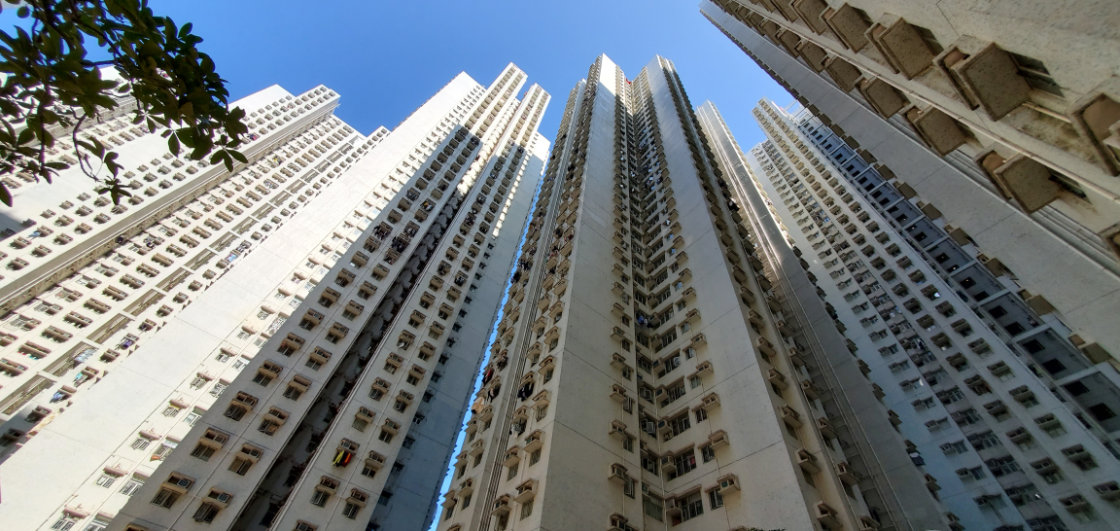




Hong Kong is a city of incredible density.1 Housing developments in the Special Administrative Region blanket swaths of the city in perhaps too many pastel towers.A These ubiquitous structures lift from cruciform,B courtyard and countless other typologies, each repeated relentlessly across the mountains and into the sea. Housing such quantities of people in so little space promotes constant interaction, and the tiered tenements display this livelihood to the world.C Residents populate the stark facades as they fill crannies and nooks with various rudiments,2 and in turn transform the towers into communities. This coalescence of culture out to dry demonstrates Hong Kong's adaptations to the monotone developments through an enlivening of interiors and exteriors with anything at all.



Hong Kong is a city of makeshift amenities. High-rise developments, with their Feng Shui formalities,D accommodate the activities of perhaps too many people. The structures leave room for playgrounds,E picnics and plenty else,F and in doing so provide an alternative to archetypical urbanisms. Housing blocks reject both modern and medieval methods of metropolizing, favouring amorphous spaces where ideologies interact and come alive to a captive globe.3 People may reside in the regulated buildings, but the spaces between offer the varieties of routine life,H and for these moments the austere towers shift to compromise. With its congested culture, Hong Kong inverts Manhattan's model into a monotony that frees the public realm (not the architecture) to be anything at all.





Hong Kong is a city of uncertain identity. Recent developments in the pseudo-city-state show how Hong Kong sits at the junction of perhaps too many crossroads. The governing structures left by the United Kingdom atop Cantonese traditions alongside mainland China interact incessantly with global markets. Housing these oft-at-odds views on jungle islands makes Hong Kong a space of ideological overgrowth and intertwining: a living planetary microcosm. The residual people, on their bleak battlefront,I take variable routes against the towering illiberal force that will inevitably dilute Hong Kong's tropical complexity. In a contest of cultures, however, Hong Kong has shown adaptability: though its architecture may seem monotonous,J its contents and contexts accommodate anything at all.K



# Date [Return to] Title
500+ Ongoing Essays
550 May 2023 Platform Gamification
504 December 2022 On the Grid
518 December 2022 A Suspended Moment
A–Z Ongoing Glossary
G September 2022 – as in Girder
F May 2022 – as in Formal
* April 2022 – Key
E February 2022 – as in Entablature
D November 2021 – as in Duck
C August 2021 – as in Czarchitect
B June 2021 – as in Balustrade
A April 2021 – as in Aalto
0–15 December 2020 Journal
15 November 2020 Practice (in Theory)
14 October 2020 Alternative Narratives beyond Angkor
13 September 2020 Urban Preservation in Cuba
12e August 2020 Conversation on Copley Square: Summations
12d July 2020 Conversation on Copley Square: Conceptions
12c June 2020 Conversation on Copley Square: Reflections
12b June 2020 Conversation on Copley Square: Nonfictions
12a May 2020 Conversation on Copley Square: Foundations
11 May 2020 Out of OFFICE
10 March 2020 Hudson Yards from the High Line
9 March 2020 Metastructures
8 February 2020 Form, Program and Movements
7 February 2020 Life in the Ruins of Ruins
6 January 2020 The Urban Improvise
5 January 2020 Having Learned from Las Vegas, or Moving past Macau
4 December 2019 A Retrospective on the Decade's Spaces
3 December 2019 The Captive Global City
2 November 2019 Temporal Layers in Archaeological Space
1 November 2019 Contemporary Art Museums as Sculptures in the Field
0 Undated Manifesto: A Loose Architecture
© 2019 – 2023 Win Overholser
Comments
Loading comments...
Powered by HTML Comment Box.